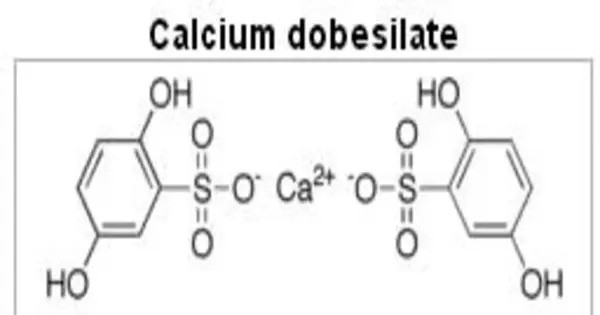Calcium dobesilate is a vasoprotective. It is the calcium salt of dobesilic acid. It is a medication primarily used to treat chronic venous insufficiency, diabetic retinopathy, and other vascular-related conditions. It is a synthetic molecule with the ability to reduce capillary permeability in the body. It is a pharmacological compound with a variety of uses, particularly in the treatment of conditions that involve vascular health and microcirculation.
It is known for its anti-inflammatory, antioxidant, and vasoprotective properties. The drug helps improve blood circulation by strengthening blood vessel walls and improving capillary permeability. In Switzerland the drug is sold by the pharmaceutical company OM Pharma under the trade name of Doxium in capsules containing 500 mg of active ingredient.
Here are some of the common uses and benefits –
- Chronic Venous Insufficiency (CVI): It helps alleviate symptoms like swelling, pain, and heaviness in the legs due to poor blood flow.
- Diabetic Retinopathy: It may help manage diabetic eye disease by improving blood circulation in the retina and reducing damage to blood vessels.
- Hemorrhoids: Sometimes used in the treatment of hemorrhoids, calcium dobesilate can reduce inflammation and improve venous tone.
Chemistry
The compound appears as a white hygroscopic powder. Very soluble in water and easily soluble in alcohol, it is practically insoluble in dichloromethane and poorly soluble in isopropyl alcohol. At the concentration of 10% the aqueous solution has a pH of between 4.5 and 6.0.
Pharmacological Properties
- Vasoprotective Effects: Calcium dobesilate has been shown to improve blood circulation by protecting blood vessels, especially in microcirculation.
- Antioxidant Action: It helps reduce oxidative stress, which can damage blood vessels and other tissues.
- Anti-inflammatory: It is sometimes used in the management of conditions that involve inflammation.
- Capillary Stabilizing Effect: It enhances the stability of capillaries, reducing leakage from the vascular walls.
- Venotonic Properties: It has effects on improving venous tone and reducing swelling and discomfort associated with conditions like varicose veins.
Pharmacodynamics
The molecule has the property of optimizing the microcirculatory function. In fact, it reduces capillary permeability both by stabilizing the basement membrane for an action on the collagen chains that constitute it, and by interacting with different biochemical mediators that favor endothelial permeability itself. In this way it favors a reduction in blood hyperviscosity and also performs an anti- platelet aggregation action.
Uses in Medicine
It is commonly used in the treatment of chronic venous insufficiency, retinopathy, and diabetic microangiopathy. It is also used in some forms of diabetic eye disease (diabetic retinopathy), as it helps protect small blood vessels in the eyes. It is also employed for hemorrhoidal conditions and other circulatory problems, providing relief from symptoms like swelling, pain, and inflammation.
Side Effects – Common side effects can include:
- Digestive issues like nausea or diarrhea
- Skin rashes or itching
- Rarely, severe allergic reactions or liver function abnormalities
















